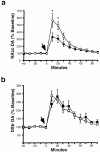Enhanced locomotor, reinforcing, and neurochemical effects of cocaine in serotonin 5-hydroxytryptamine 2C receptor mutant mice
- PMID: 12427861
- PMCID: PMC6757823
- DOI: 10.1523/JNEUROSCI.22-22-10039.2002
Enhanced locomotor, reinforcing, and neurochemical effects of cocaine in serotonin 5-hydroxytryptamine 2C receptor mutant mice
Abstract
Brain serotonin [5-hydroxytryptamine (5-HT)] systems substantially influence the effects of cocaine; however, the contributions of individual 5-HT receptor subtypes to the regulation of cocaine responses are unclear. A line of mutant mice devoid of 5-HT2C receptors was used to examine the contribution of this receptor subtype to the serotonergic modulation of cocaine responses. Mutants display enhanced exploration of a novel environment and increased sensitivity to the locomotor stimulant effects of cocaine. In an operant intravenous self-administration model under a progressive ratio schedule of reinforcement, mutants display elevated levels of lever pressing for cocaine injections, indicating that the drug is more reinforcing in these mice. Moreover, mutants exhibit enhanced cocaine-induced elevations of dopamine (DA) levels in the nucleus accumbens, a brain region implicated in the stimulant and rewarding properties of cocaine. In contrast, phenotypic differences in dorsal striatal DA levels were not produced by cocaine treatment. These findings strongly implicate 5-HT2C receptors in the serotonergic suppression of DA-mediated behavioral responses to cocaine and as a potential therapeutic target for cocaine abuse.
Figures




Similar articles
-
5-HT(6) receptor antagonism potentiates the behavioral and neurochemical effects of amphetamine but not cocaine.Neuropharmacology. 2002 Feb;42(2):170-80. doi: 10.1016/s0028-3908(01)00165-4. Neuropharmacology. 2002. PMID: 11804613
-
Behavioural sensitization and enhanced dopamine response in the nucleus accumbens after intravenous cocaine self-administration in mice.Eur J Neurosci. 2003 Feb;17(3):590-6. doi: 10.1046/j.1460-9568.2003.02491.x. Eur J Neurosci. 2003. PMID: 12581176
-
Cocaine acts on accumbens monoamines and locomotor behavior via a 5-HT2A/2C receptor mechanism as shown by ketanserin: 24-h follow-up studies.Prog Neuropsychopharmacol Biol Psychiatry. 2004 May;28(3):547-57. doi: 10.1016/j.pnpbp.2004.01.007. Prog Neuropsychopharmacol Biol Psychiatry. 2004. PMID: 15093963
-
Neurokinin3 receptor modulation of the behavioral and neurochemical effects of cocaine in rats and monkeys.Rev Neurosci. 2008;19(2-3):101-11. doi: 10.1515/revneuro.2008.19.2-3.101. Rev Neurosci. 2008. PMID: 18751518 Review.
-
Neuropsychotoxicity of abused drugs: effects of serotonin receptor ligands on methamphetamine- and cocaine-induced behavioral sensitization in mice.J Pharmacol Sci. 2008 Jan;106(1):15-21. doi: 10.1254/jphs.fm0070121. Epub 2008 Jan 16. J Pharmacol Sci. 2008. PMID: 18198473 Review.
Cited by
-
Animal models of obsessive-compulsive disorder: utility and limitations.Neuropsychiatr Dis Treat. 2015 Aug 4;11:1939-55. doi: 10.2147/NDT.S62785. eCollection 2015. Neuropsychiatr Dis Treat. 2015. PMID: 26346234 Free PMC article. Review.
-
The effects of the 5-HT(2C) receptor antagonist SB242084 on locomotor activity induced by selective, or mixed, indirect serotonergic and dopaminergic agonists.Psychopharmacology (Berl). 2006 Sep;187(4):515-25. doi: 10.1007/s00213-006-0453-9. Epub 2006 Jul 11. Psychopharmacology (Berl). 2006. PMID: 16832658
-
Effects of Alcohol and Cocaine in a Mutant Mouse Model of Predisposition to Post-Traumatic Stress Disorder.Front Pharmacol. 2020 May 8;11:623. doi: 10.3389/fphar.2020.00623. eCollection 2020. Front Pharmacol. 2020. PMID: 32477119 Free PMC article.
-
Editing of neurotransmitter receptor and ion channel RNAs in the nervous system.Curr Top Microbiol Immunol. 2012;353:61-90. doi: 10.1007/82_2011_157. Curr Top Microbiol Immunol. 2012. PMID: 21796513 Free PMC article. Review.
-
The serotonin 5-HT2C receptor and the non-addictive nature of classic hallucinogens.J Psychopharmacol. 2017 Jan;31(1):127-143. doi: 10.1177/0269881116677104. Epub 2016 Nov 15. J Psychopharmacol. 2017. PMID: 27903793 Free PMC article. Review.
References
-
- Azmitia EC, Segal M. An autoradiographic analysis of the differential ascending projections of the dorsal and median raphe nuclei in the rat. J Comp Neurol. 1978;179:641–668. - PubMed
-
- Bengel D, Murphy DL, Andrews AM, Wichems CH, Feltner D, Heils A, Mossner R, Westphal H, Lesch KP. Altered brain serotonin homeostasis and locomotor insensitivity to 3,4-methylenedioxymethamphetamine (“ecstasy”) in serotonin transporter-deficient mice. Mol Pharmacol. 1998;53:649–655. - PubMed
-
- Benuck M, Lajtha A, Reith MEA. Pharmacokinetics of systemically administered cocaine and locomotor stimulation in mice. J Pharmacol Exp Ther. 1987;243:144–149. - PubMed
-
- Bhat RV, Baraban JM. Activation of transcription factor genes in striatum by cocaine: role of both serotonin and dopamine systems. J Pharmacol Exp Ther. 1993;267:496–505. - PubMed
-
- Brodie MS, Bunney EB. Serotonin potentiates dopamine inhibition of ventral tegmental area neurons in vitro. J Neurophysiol. 1996;76:2077–2082. - PubMed
Publication types
MeSH terms
Substances
Grants and funding
LinkOut - more resources
Full Text Sources
Other Literature Sources
Medical
Molecular Biology Databases
